Photo Archive
for
MUSIC ACTS
2004
through
2006

Photo Archive
|
|
MUSIC ACTS
|

|
Lighted by
|
|
(Although viewable at a 640-pixel horizontal
resolution, setting your browser to 800 or 1024
would be better for this page.
Events are in reverse chronolgical order.)
The Maritime Beatle Event
The Pub Venue
Maritime Beatle Event: Unplugged
Free Preview Night
Our Friends Pub
Dartmouth, Nova Scotia
June, 2006
|
The Repeatles
|
|
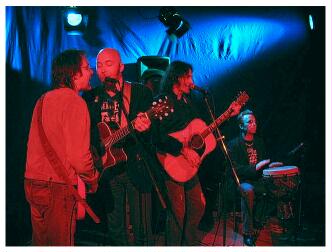 |
The band is bathed in intense, but soft red
from two sides to give an even wash to each
performer. Blue back lighting gives form and
separates them from the background. Fixtures
used for both were 500-watt fresnels (frah-nell)
sporting barndoors to control spill in the close
quarters of the small performance area in this
venue.
|
|
Behind, a blue cloth is used to hide a normally
cluttered corner and present a cleaner stage.
Two 500-watt PAR 56 fixtures flood the drop at
acute angles, one from each side. This highlights
its blue colour while providing additional contrast
and form to musicians as illuminated by the front
reds.
|
|
Hal Bruce
|
|
|
Since this was a static-look for the entire evening,
Hal is seen under the same lighting as in the above
photo. More of the blue backdrop is visible from this angle. The apex of the corner is between the two back lights hanging to the right of Center Top. Note that where ever the backdrop lights are not focused appears black. While much of this is due to the excessive contrast of the photo not showing weaker blue lighting down lower on the drop, it is also because the blue colour of the drop does not reflect the front red as well, so it appears dark. |
 |
|
This style of lighting and set design is very
conducive to confined spaces because it provides
good separation of colours, background, and
artists despite their close proximity.
|
The Main Venue
Maritime Beatle Event
Saint Antonio's
Olympic Community Centre
Halifax, Nova Scotia
June, 2006
Here are two looks at Richard's venue lighting for the
main show in Halifax. Four 1000-watt fresnels splash red
on to the curved white-tile ceiling. Two of these lights
are visible as over-exposed white spots above the girder
at extreme Upper Left and Right. The indirect soft red
flooded the entire venue to provide a pleasant atmosphere.
Barndoors were placed on each fixture to shield patrons'
eyes from direct light when walking along the balcony
aisles. The blue colour illuminating the central girders was not permanent. It only occurred when that particular look was used on the stage. The white rectangles above and to each side of the stage are video screens, while the white at Lower Right is daylight spilling in from an open stage door. Further to the technical aspects of this show, behind the speaker stack at stage right (your left) is the monitor audio position, and just beyond that lies the dimmer setup and main stage power. Note at Lower Right the extreme left edge of the house audio board. |
|
The crowd on the main floor near the hall's
entrance views the show from a low angle.
At extreme Upper Left is one of the venue
fresnels focused toward the back of the venue
and bouncing red light from the ceiling. The
steel work surrounding it is being illuminated
by another fresnel from out of frame left. It is
focused toward the front. Along the girder closest to the performers, front-of-house stage lights are silhouetted. These consist of rows at each side of short-throw, wide-angle PAR 64s for wash, and separated ellipsoidals for key lights on each individual musician. The two arcs of lights closer to the stage canopy are a special setup of PAR 46 marine-style lamps. (More on them in a later photo.) |
Notice the range of colours across the venue ceiling.
In the balcony on each side is red profiling the
girders and curved ceiling, while the stage and
above take on the colours of each scene. This
provides a total atmosphere for the patrons as
they enjoy the performances.
|
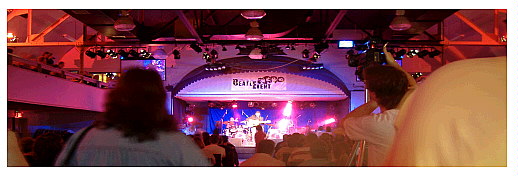 |
Abbey Road |
|
In this closer view, the band is lit
generally in an orange wash provided by the
red and amber wide-angle PAR 64s, and lit
individually by ellipsoidals fitted with
gold-tinted filters. These front key-lighting
fixtures are silhouetted at the top of the image.
Two of them can be seen left of Center Top pushing
light toward the stage. PAR 64 Ray Lights provide tubes of medium blue from behind as projected through a light mist. Two come from central, high-angle positions, while the outside fixtures are from a much lower angle. Utilising multiple lights from widely-separated angles in this manner, gives depth and a sense of space to the small, low-ceilinged stage. |
|
Abbey Road
|
|
|
Deep blue smothers the band from front
wide-angle PARs. This is enhanced on the
small stage by the use of a blue backdrop
as was explained in the `Our Friends Pub'
photos farther back. At stage right (your left), the bass player is highlighted by a single front key light provided by a gold-tinted ellipsoidal. It looks more orange here because it has been dimmed in intensity to match the deep blue mood. The mauve beams from behind come from PAR 64 Ray Lights and provide contrast to the front blue and gold. |
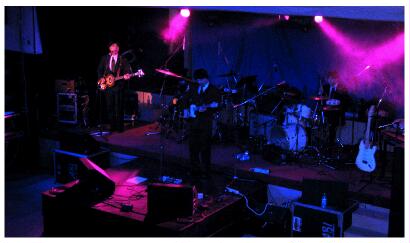 |
|
Realise the excellent separation of colours
that this setup provides - even on such a small
stage. This focuses the audience's attention
on the most prominent musician during each
section of a given song.
|
|
Ticket 2 Ride A soft pink wash produced by combining red and blue front lights blankets the stage, while downstage center is lit from two angles by ellipsoidals using a gold tint. The angles of these key lights may be discerned from the shadows cast upon the stage behind guitarist Hal Bruce. Blue Ray Lights from rear upper and lower positions create atmosphere in a slight haze. |
The magentas and purples surrounding the stage are achieved
by high-angle side wash lights attached to a balcony railing
on each side of the stage. As with the front wash, wide-angle
PAR 64 short-throw fixtures were used, but with the lamps
rotated to give a vertical oval pattern that slashes completely
across the front. In this scene, side-wash blue is used to
combine with the front pink in order to create those
alternate-colour casts. |
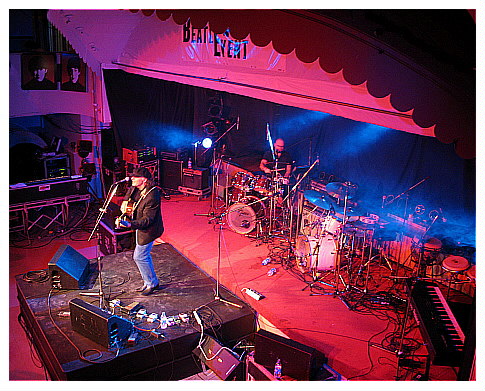 |
|
|
Note the blue highlights where the "Beatle Event" sign
wrinkles. No alternate colours occur here because the
wrinkles are face-on to the blue side lights, but are
side-on to the front pink. Being shadowed from that
pink, they `see' only the blue side colour. Although no pink light shines directly on the underside of the stage canopy, there is reflected pink from the white vertical surface below it. It weakly combines with the side blue and achieves a nice violet tinge at its darkest. This usage of light & shadow and direct & reflected light makes for a graduated-fill style of colouring, giving more form and dimension than direct light alone can achieve. At Center Left is the audio monitor console. Above it hang posterboard images of George Harrision and Paul McCartney. |
|
Jay Goeppner Backed by The Repeatles and Ticket 2 Ride |
A bright scene is captured from behind the
stage-left speaker stack. It consists of a
red front colour coupled with several
ellipsoidals that dilute the red into a
light, bright wash. At Upper Left are two
of three side lights that occupy the balcony
rail position above stage right. The green
and red there combine to give a yellow side
wash, further brightening the scene. With all
these lights combined, it is now so bright
that the back turquoise appears to be lost as
viewed from this angle but can be seen
reflecting off the ceiling, some of the stage
instruments, and on the back of guest guitarist
Mark Rashotte from the Beatle tribute group
All You Need is Love.
|
|
A blurred Jay is all anyone will see of this
performer; he is that energetic.
|
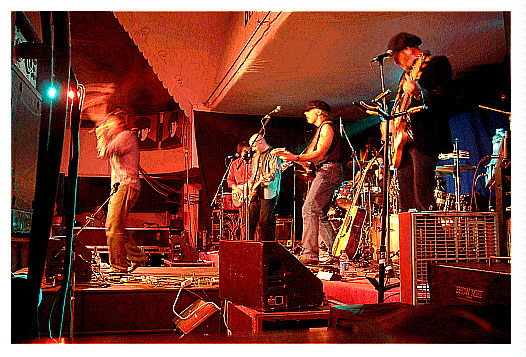 |
|
The low angle of this photo affords a
look at the underside of the stage canopy.
Its curvature and white-coloured tiles
make for a good surface from which to
bounce light. The photos in the "Canopy"
section after the next image show the effect
of light reflected from there. Note at Lower Right the Showmist fog generator that provided the mist, haze and fog for this show. The fan seen in front of the unit directed the fog across the stage. |
|
Jay Goeppner Backed by The Repeatles and Ticket 2 Ride |
This view uses PAR 46 aircraft landing lights fitted with ultra-blue gel. One floor mount with four fixtures is placed behind each of the two drum kits. This provides four beams per colour, two from each mount. (Green is the other colour; it may be seen in a later photo.) The blue beams here are punctuated via five individual pinspots with a light pink gel. These pinspots are positioned with the three central fixtures at higher points than the two side ones in order to give dimension. |
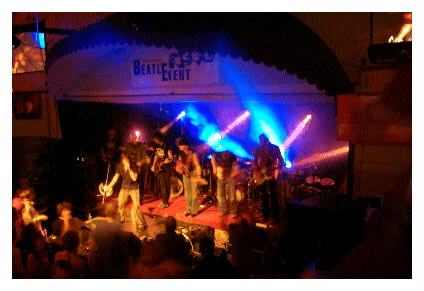 The only front lighting in this scene is provided by two central key lights which are ellipsoidals with gold-tinted gel. Note that part of this scene is depicted on the video screens at Upper Left and Upper Right. |
The Canopy
Maritime Beatle Event
Saint Antonio's
Olympic Community Centre
Halifax, Nova Scotia
June, 2006
The usage of this venue's stage canopy will be featured in the next few
views. PAR 64 narrow spots on tripod stands beam pink or orange from
off stage up on to the underside of the stage canopy. There is one
fixture per colour, per side for a total of four. Their actual focus
points are hidden from most audience members because of the `fretwork'
valance on the canopy's front. However, their reflections illuminate the
"Beatle Event" sign and provide top lighting for the musicians from an
otherwise impossible angle in this venue. This indirect technique was
used because the canopy itself is in the way of any lights that might
ordinarily be hung for the purpose of top lighting.
Abbey Road
 |
In this shot, no front lighting is used at
all. Blue back lights are contrasted by a
soft pink from above. From a distance, as
seen here, the canopy nicely frames a bright
area above the stage and also shows off the
"Beatle Event" sign.
|
|
Here is a closer shot of a similar scene
except that the rear blue is coming from
low-angle PAR 46 aircraft landing lights
and it is deeper in colour. |
Abbey Road
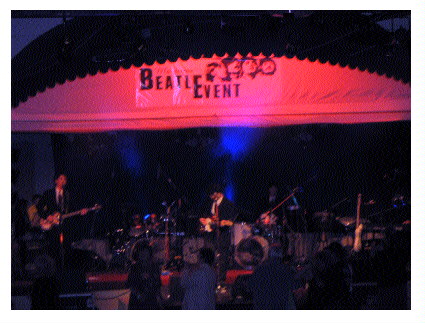 |
The Repeatles
 |
Bass player Arne Leirnes gazes at the orange
reflecting from the canopy. The source for
one of the beams may be see at Lower Right.
As you can see, it is fairly low in height
but not down at floor level. This gives the best
angle to hit the curved tile surface above. This
scene also uses front red and rear turquoise.
|
|
Green hovers in the air over the performers. It is
achieved by PAR 46 aircraft landing lights shot from
a low angle into fog over top of the drum kits. The
central area is lit by front ellipsoidals dimmed to
take on an orange look, although here the camera shows
it as red.
|
The Finale
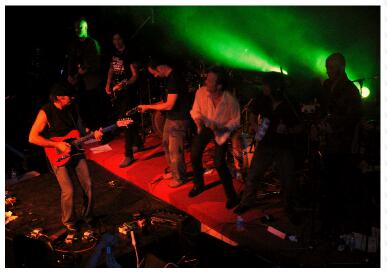 |
|
The Finale
|
|
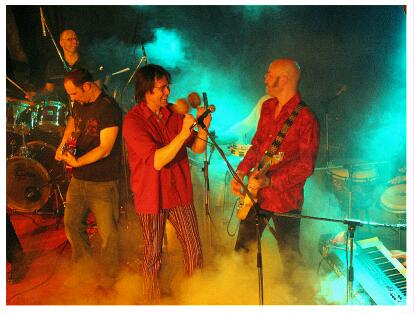 |
This close-in shot shows musicians from several
of the acts on the bill bathed in red. Fog swirls
around their feet and up behind their backs where it
takes on the colour of the rear turquoise lights. The
front red is from the PAR 64 wide floods and gives a
very soft and even wash. Once again, the back beams are
provided by close-proximity PAR 64 Ray Lights.
|
|
Note at Center Bottom where the fog takes on a yellow
tint despite there being no lights of that colour
in this scene. This is achieved where the red front
wash combines with the green component of the rear
turquoise to produce a third colour: yellow.
|
|
Show's End For the very end, some lights behind the band shoot rays through thick fog while other lights are brought up dimly to simply make their presence known. The canopy lights colour it and the "Beatle Event" sign in orange. Red washes the stage from front positions. 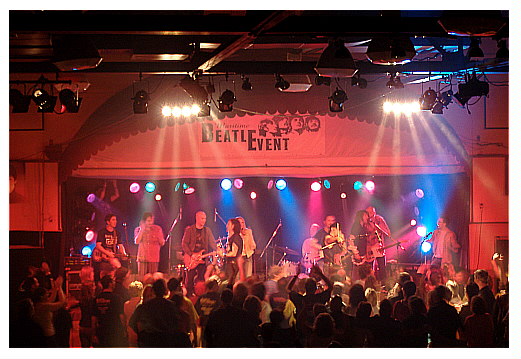 Out above the dance floor in front of the canopy are the curved fixtures with the marine-style lamps, as mentioned earlier. Five PAR 46 lamps are arranged in an arc within each enclosure so as to fan out the beams across the audience. When viewed directly, the unshielded filaments give a glistening effect; yet at the same time, crisp, slender beams are projected into the crowd from parabolic reflectors behind those same filaments. |
|
Ladder Boy The audience views Richard as he reaches up to nearly five metres above the main floor to focus an errant light that had drooped shortly after the show's opening. An Ellipsoidal is a heavy stage light that requires extra tightening of its adjustment hardware. This is due to the 1000-watt light source's extreme heat causing tolerances to increase. The effect is one of slightly loosening this hardware so the front-heavy fixture tends to pivot downward. Richard had failed to secure this one well enough during the final preshow focus, so after heating up during the opening act, it drooped slightly. |
|
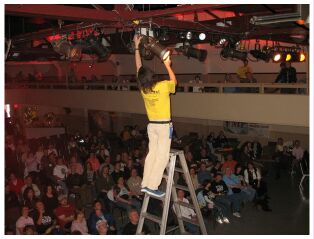 |
Although only a bit off the mark, rather than
suffer with it for the remaining eleven-plus
hours of the event, and also take the chance
that it would not droop further, he waited till
announcements were being made between acts and
quickly left the lighting director's position,
at extreme Center Left in the balcony. Grabbing his trestle ladder stored next to the stage, he quickly brought it out under the light, set it up, climbed to near the top, refocused and tightened the light, climbed back down and closed and removed the ladder. This entire operation was done in under 90 seconds. |
|
This close-up view also provides a better look
at the spaced row of ellipsoidals used for
individual key lights, and at the right, the
close series of six wide-angle, short-throw PAR
64s used for general washes. Another set of
them hangs out of frame to the left.
|
|
November Nite
Brightwood Golf and Country Club
Dartmouth, Nova Scotia
November, 2005
|
The band is lit in a wide-angle, soft red
from the front. The guitarist is profiled by a
single ellipsoidal spot from his front right. Behind,
green washes emanate from side positions, while
turquoise PAR 64 Ray lights beam down to the two
outside guitar positions. Each one is hit from a
near, high angle and a far, low angle in
mirror-image symmetry.
|
Donna Scaglione backed by The Time Bandits 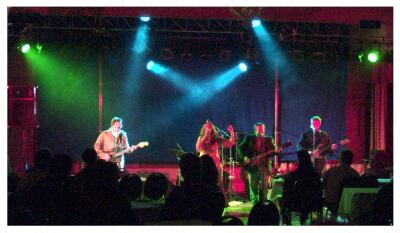
|
|
Hal Bruce and Donna Scaglione backed by The Time Bandits |
|
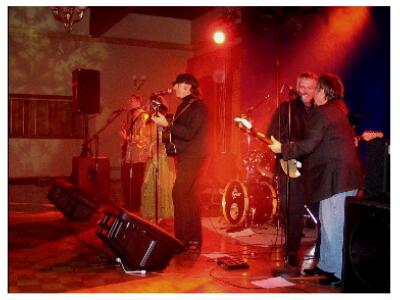 |
This scene is lit from the front by a wide-angle
red wash with white highlights provided by the camera
flash. From behind, intense red and orange pierce
through fog to provide backlighting on the musicians.
At the far left is a "Snowflake" pattern projected
on the side wall as part of the venue atmosphere.
|
|
Here is a closeup of Donna. She is highlighted from
behind by a deep blue projected from rear stage right,
while the same from farther away stage left provides
soft blue fill. A single key light from front stage right
profiles her from one side while allowing deep shadow on
the other. This key light has a warming tint and is reduced
to a low intensity to create a sombre mood.
|
Donna Scaglione

|
|
Time Bandits with Hal Bruce |
|
|
The band here is lit with a front soft red wash. This is contrasted by wide green washes from two rear side positions and narrow turquoises located closer to center. Only the stage-right fixtures are visible here. |
 The back greens illuminate all the front-line performers while the turquoises only hit the stage-right singer and stage-left guitarist. Being brighter, they over power the green on those two from that angle only. However, they blend with it as one moves farther away from the intensity of the turquoise beams. |
Time Bandits
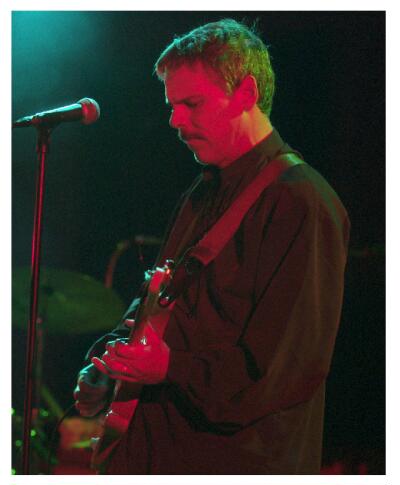 |
Here is a closer view of the same lighting look as above. It shows the colour separation on an individual musician. The soft front red is contrasted by green from stage left and turquoise from stage right. The colours are kept apart by paying attention to the location and angle of each lighting fixture. This gives form and dimensionality to the performer, especially when viewed from a distance. |
|
Note the blending of the top turquoise and lower-angle
green as they follow the form of the top & back of
guitarist Gerry Albert's hair, yet still staying separate
from the red on his face, ear and neck.
|
|
Time Bandits with Donna Scaglione |
|
|
Deep blue surrounds the band for a soft look
from front and rear side angles, while contrastingly
lighter blues hit the drum kit from steeper rear angles.
A single spot with a warming tint highlights the stage-right
guitar player from a front, right side position.
|
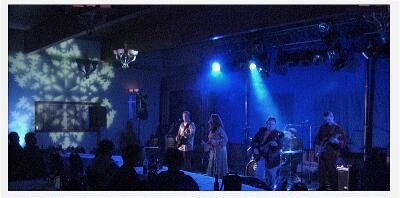 In this wide-angle photo, the "Snowflake" pattern is evident once again. Note the shadow of one of the venue's chandelier lighting fixtures near the upper right of the projected image. The angle could not be adjusted to pass by the chandelier and still have the pattern be on a relatively clear wall space with minimal keystoning. Out from the wall, the missing part of the image may be seen shining on the offending ceiling fixture. |
Time Bandits
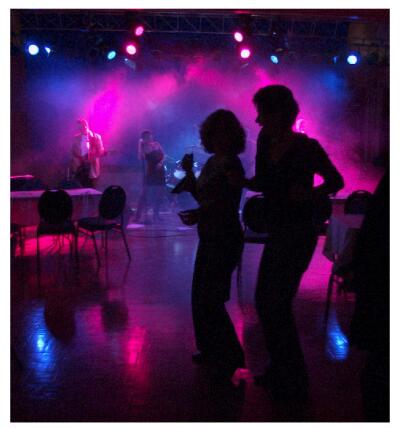 |
Dancers are silhouetted against two-tone blue
band lighting coupled with narrow pink highlights.
The pink beams are produced by four PAR 64 Ray
lights from central high and low positions.
The back lights are reflected in the venue's
polished wooden floor, and thick fog adds
a misty haze to the stage scene.
|
Jimmy Jam
Saint Antonio's
Olympic Community Centre
Halifax, Nova Scotia
October, 2005
|
Ticket 2 Ride
|
|
|
This look is achieved with a colour-corrected
spot from the front giving a warm incandescent feel
to the guitarist. At the rear are two PAR 64 ray
lights bathing the drums in lavender.
|
 The white fingers are done by using triangle-configuration splitter patterns, one in each of four ellipsoidal spots having 37-degree spreads. This produces a total of 12 beams. There is one on either side of the drum kit on floor bases, and one each on vertical pipes at extreme stage left and right. A slight haze allows the beams to be visible. (The not-seen stage-right light is out of frame to the left, while the floor one to the drummer's immediate left is pointing away from the camera, so its beams are less noticible in this picture.) |
Canadian Primos
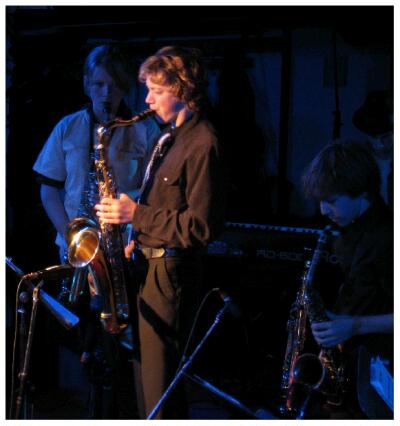 |
A saxophone player is knifed from the blue in
this photo. This is achived by deep blue front
and side washes along with a sharply-focused
ellipsodial on the main player from an almost
straight-on, but medium-high angle. Note how
precisely he is separated from his fellow players
despite their close proximity. A colour correction
filter gives him a warm look to contrast the cold
blue.
|
|
Garfield and Arlene
|
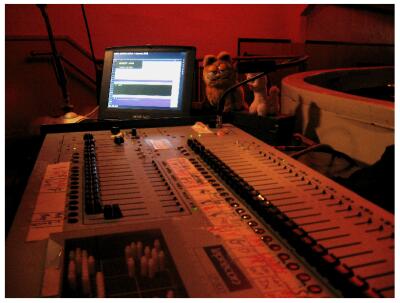 |
|
This is the upstairs front-of house lighting
director's position. Garfield and Arlene stand
watch over the lighting console, which for this
show is a Leprecon LP-900. To our left of them
is a Hewlett-Packard N3438 Pavilion Notebook.
Normally used for lighting cue purposes, here
a 1-2-3 spreadsheet displays the artist lineup
for the evening.
|
|
Sham*Rocks CD Release Brightwood Golf and Country Club Dartmouth, Nova Scotia March, 2005 |
|
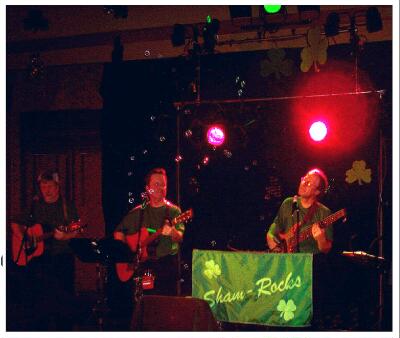 |
Three of the band members seen here are lit with
a red front wash. Pink spots highlight from behind
while a green top wash adds form. Bubbles compliment
the scene and reflect the colours used.
|
|
Sham*Rocks Brightwood Golf and Country Club Dartmouth, Nova Scotia March, 2005 |
|
|
A similar scene to the above is shown here,
but from a side angle. Once again, a red
front wash with pink back lighting illuminates
the band and bounces colour off the bubbles. Iridescent shamrock cutouts by set designer, Carol Cunningham, hang above and behind. They also reflect the scene's colours. |
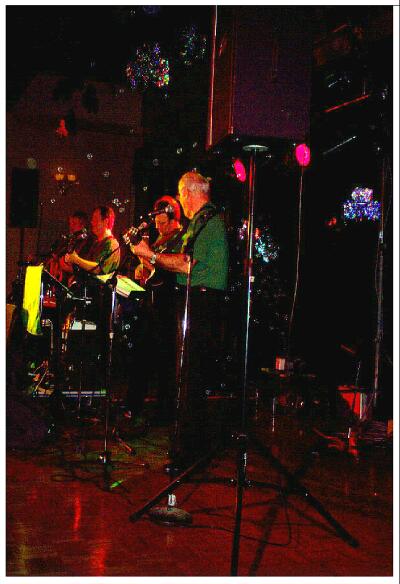 |
|
Saltwater Roses Holiday Inn, City Centre Halifax, Nova Scotia February, 2005 
|
A production shot of Saltwater Roses (minus the horn players and one guitarist) shows them lit from the front in a pink, and from the rear in blue. At the top of the image is a bar of Lighting & Elecctronics short-throw PAR 64 fixtures. Its red and blue lights are on in order to produce the front pink colour. |
|
Note at the wall/ceiling boundary behind
the band the blending of colours toward
the violet end of the spectrum. Due to
fixture positions and focusing, the red
happend to have had less effect near the
left ceiling for this particular light setup.
However, it still tints the blue enough to
produce a purple cast. This colour change may
be seen by following the blue above the far left
fixture across the ceiling and down the back wall.
It changes from blue to violet to purple, back to
violet and then to pink as the blending takes place.
|
|
Here are several members of the band lit from
the front in thick red and from acute side angles
in deep blue. An additional gold tint from an
ellipsoidal highlights the front guitarist/vocalist.
|
Saltwater Roses Holiday Inn, City Centre Halifax, Nova Scotia February, 2005 
|
|
Bluesmith at Bonn-Ami Monte's Bar & Grill Dartmouth, Nova Scotia September, 2004 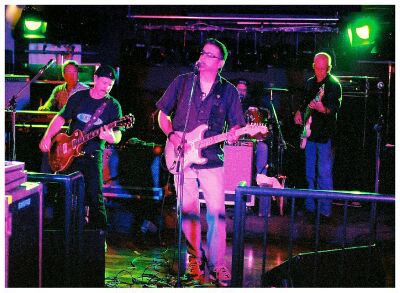 |
The band members are lit with a soft, wide-angle
pink from the front. It is achieved by combining
red and blue lights - one red and one blue from each
of two side positions. A clue to the usage of this
technique may be seen in the colour shadows of the
railing on the center guitarist's pants. There is one
shadow for each of the red and blue colours.
|
|
In areas where the colours combine to a lesser extent,
such as extreme left & right upstage, the stronger red
colour overtakes the blue. This may be seen on the faces
of the keyboard and bass players. Intense lime greens wash from rear corner angles to achieve dimension on the small stage. The back lights in this venue hang low because of the ceiling height. The wide-angle ones, three at each side, are barndoored to shield the audience from glare due to their shallow angle. The center lights above the drum kit (which are not on in this scene) are in long-throw fixtures and are focused further upstage. Thus, they require no additional shielding. |
|
Thanks to photographers Babs Walker, Colin Conrad, Shirley Robb, and
Ully Bleil of the Halifax-Dartmouth, Nova Scotia area for usage of their
photos. |
|
Return to the |
Return to the |
|
Go to the |
|